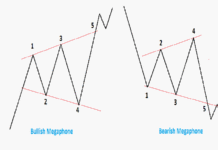
In the world of forex trading, understanding and recognizing patterns can significantly enhance your ability to make profitable trading decisions. Among the various patterns that traders employ, the key reversal pattern stands out as a powerful tool for identifying potential trend reversals and capturing significant market movements. Mastering this pattern can provide traders with valuable insights and help them make informed trading choices. In this article, we will delve into the key reversal pattern, explore its characteristics, and discuss strategies for effectively utilizing it in forex trading.
The key reversal pattern, also known as the engulfing pattern, is a two-candlestick formation that occurs at the end of an existing trend. It is characterized by a strong reversal signal, indicating a potential change in the direction of the market. This pattern consists of two candles: the first candle represents the existing trend, while the second candle engulfs the first, erasing its gains or losses. The color of the second candle is opposite to that of the first, indicating the reversal.
There are two types of key reversal patterns: the bullish key reversal pattern and the bearish key reversal pattern. The bullish key reversal pattern occurs at the end of a downtrend, signaling a potential reversal to an uptrend. It is identified by a bearish (red or black) candlestick followed by a larger bullish (green or white) candlestick that engulfs the previous candle’s body. This pattern suggests that buyers have overwhelmed sellers and are likely to push the market higher.
Conversely, the bearish key reversal pattern appears at the end of an uptrend, indicating a potential shift to a downtrend. It is characterized by a bullish (green or white) candlestick followed by a larger bearish (red or black) candlestick that engulfs the prior candle. This pattern suggests that sellers have gained control, overpowering the buyers and potentially leading to a downward movement in the market.
Read more: Technical Analysts Keep a Watchful Eye on Head and Shoulders Pattern Formation
To effectively utilize the key reversal pattern in trading, it is crucial to consider a few key factors. First and foremost, traders should look for this pattern in significant areas of support or resistance on the price chart. These levels act as barriers that the market may struggle to break, increasing the likelihood of a reversal. Additionally, traders should pay attention to the overall market context, such as fundamental news events or technical indicators, to confirm the validity of the pattern and reduce the risk of false signals.
Another important consideration is the size and volume of the engulfing candle. A larger engulfing candle signifies stronger momentum and conviction from the buyers or sellers, increasing the reliability of the reversal signal. Similarly, higher trading volume during the formation of the pattern confirms the market’s interest and participation in the potential reversal.
Risk management is a crucial aspect of trading, and employing proper risk-reward ratios is vital when trading key reversal patterns. Traders should place stop-loss orders below the low of the bullish key reversal pattern or above the high of the bearish key reversal pattern to limit potential losses if the market fails to reverse as expected. Profit targets can be set based on nearby support or resistance levels, previous price swings, or by utilizing trailing stops to capture additional gains if the market continues to move in the anticipated direction.
In conclusion, mastering the key reversal pattern can significantly enhance a trader’s ability to identify potential trend reversals and capitalize on profitable trading opportunities in the forex market. By recognizing the characteristics of this pattern, considering its formation within significant support or resistance areas, confirming signals with market context, and effectively managing risk, traders can increase their chances of success. However, it is important to remember that no pattern or strategy guarantees success in trading. Practice, discipline, and continuous learning are essential elements in becoming a successful forex trader.



























